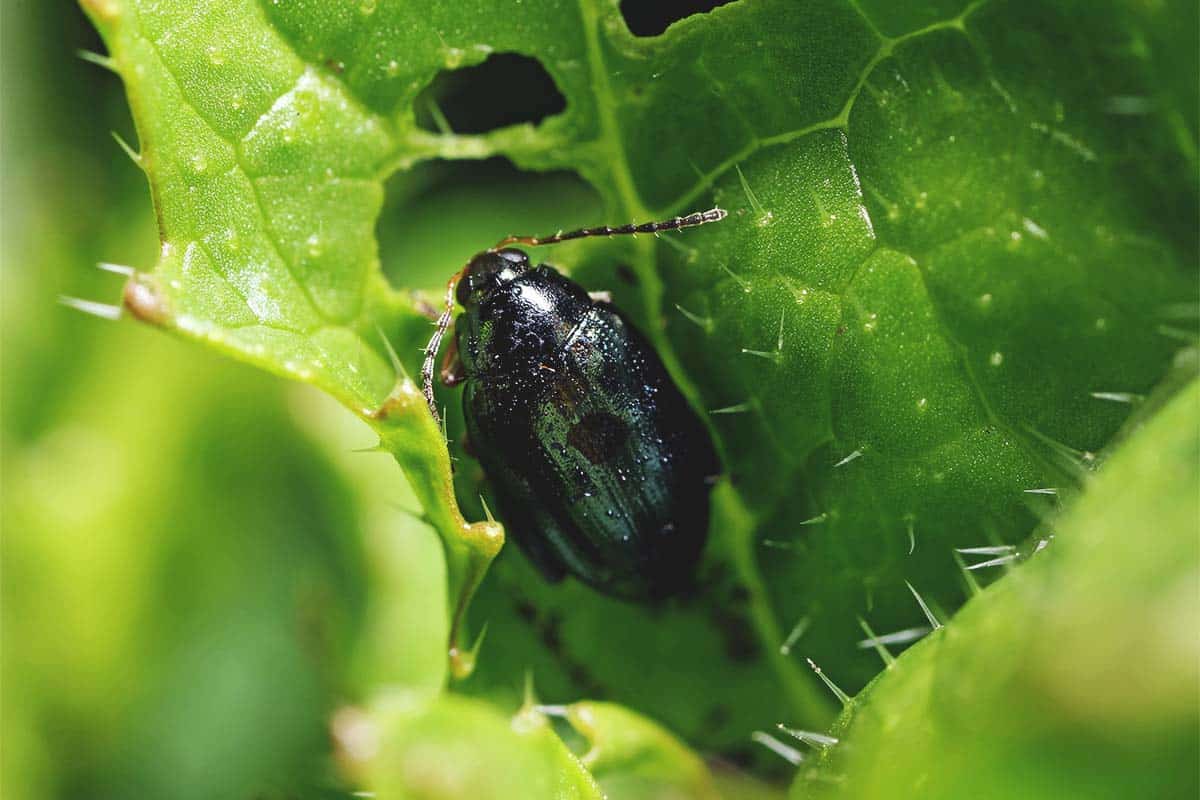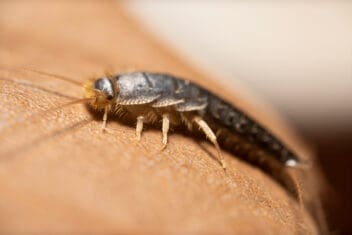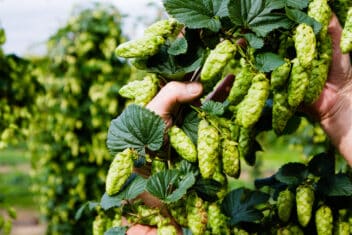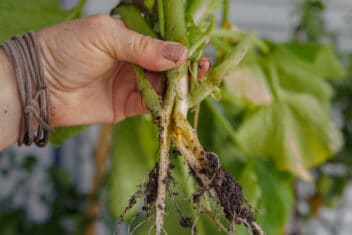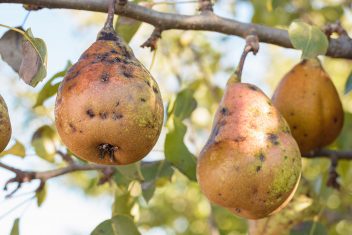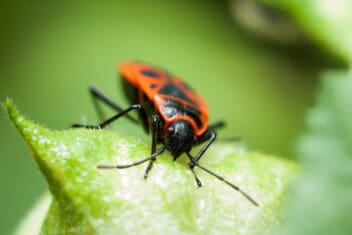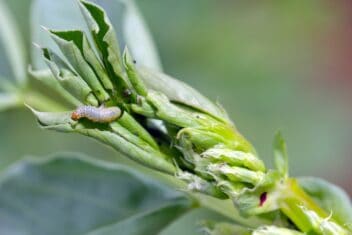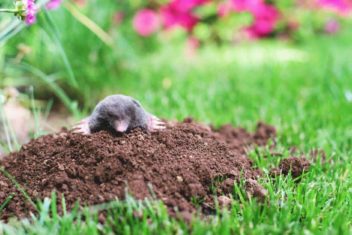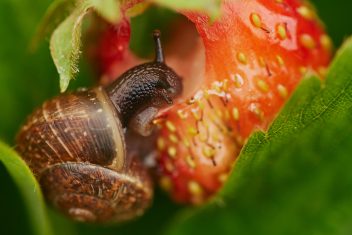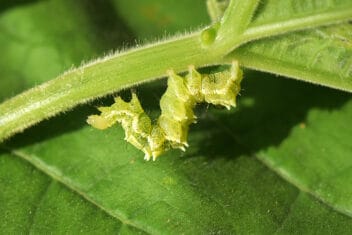Each year it seems like a whole new type of bug decides to move into my garden. I’ve become well-acquainted with the many varieties of nasty insects that can wreak havoc on plants – including flea beetles.
Being able to identify bugs is the first and most crucial step in getting rid of them. Thankfully, some are easier to spot than others. Flea beetles are a lot less sneaky than other ugly garden critters.
Want to find out more about this annoying garden pest? Read on to find out what they are and how to stop them in their tracks should you discover an infestation.
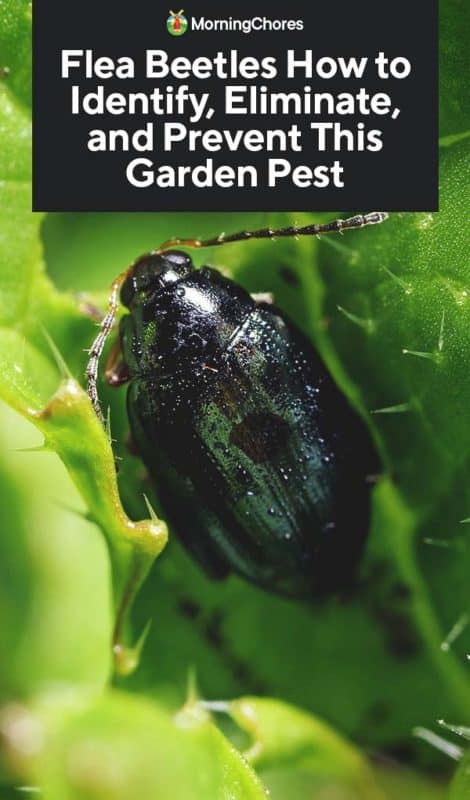
What are Flea Beetles?
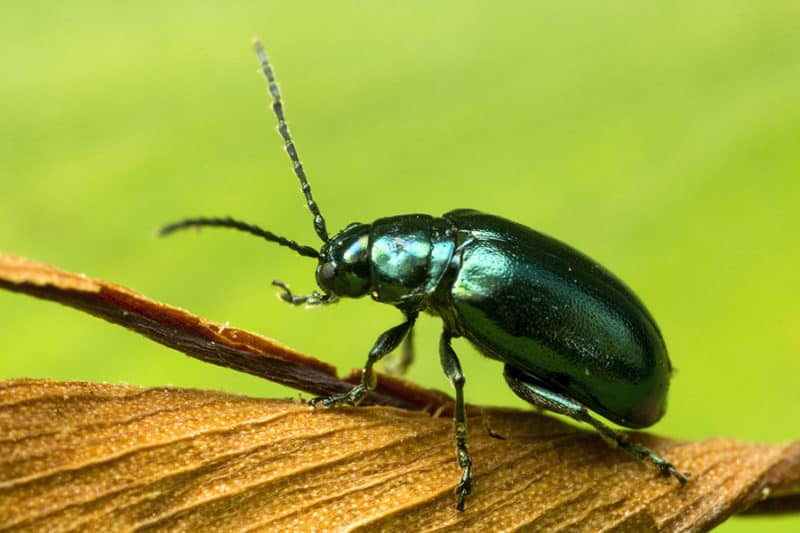
Flea beetles are small, beetle-like bugs. There are quite a few species, but we’ll be focusing the ones that munch on edible garden plants.
They can be a variety of colors, though black is most common. Coloring depends on the species. You’ll know you’ve spotted a flea beetle if you approach, and they quickly jump away like a flea.
These annoying bugs can be seen by the naked eye, unlike actual fleas, but they share the same name because of their ability to jump far and quick. They have a shiny carapace and, in their adult form, measure about 1/16th of an inch long.
Different types of flea beetles may be attracted to different kinds of garden plants, but typically they attack those in the nightshade and brassica family.
Here’s a quick breakdown of beetle types that can attack your garden crops:
- Crucifer flea beetle: an all-black beetle that targets brassica crops.
- Western black flea beetle: this pest has a shiny dark green appearance.
- Striped flea beetle: a beetle with striped wings with a shiny black or greenish carapace.
- Potato flea beetle: this bug is a mostly black beetle that targets potato plants.
- Eggplant flea beetle: this is a mostly black bug that targets eggplants.
The Flea Beetle Lifecycle
Flea beetles lay their eggs at the bottom of plant stems. Egg-laying occurs at the start of the summer once the adult beetles have had enough time to feed on plant material. Once hatched, larvae munch on plant roots.
They tend to do the most damage at the start of a season once they’ve emerged from their winter hiding spots in the early spring.
Signs of Flea Beetle Activity
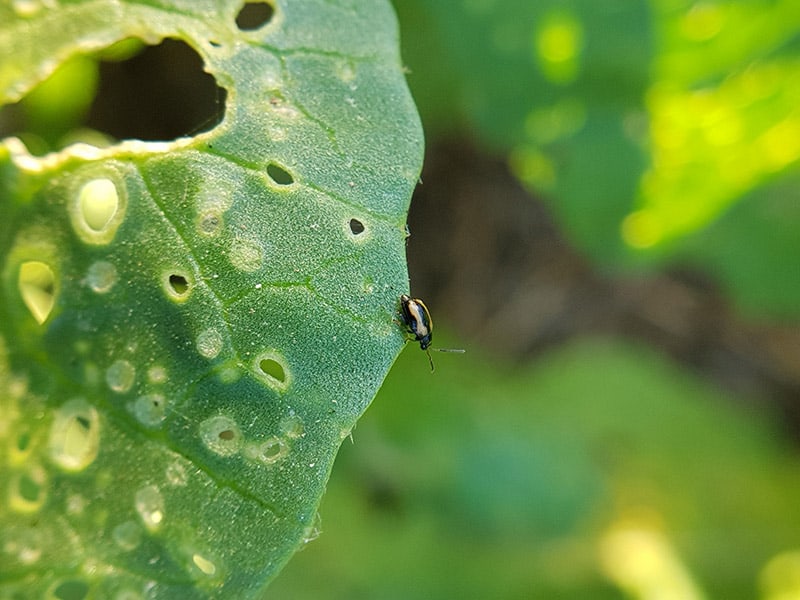
Adults eat the foliage of plants and leave behind holes in the foliage. You will see damage on plants of all sizes, but the damage on seedlings is the most concerning since it can quickly kill vulnerable young plants.
Of less concern is the damage to established plants. Flea beetles eat the foliage, but it’s rarely enough to kill a plant altogether, though a large infestation can do some pretty serious damage.
The biggest concern is that these beetles are potential carriers of disease and pathogens that can absolutely decimate your crops. Leaving them to feast on the material in your garden is a great way to invite diseases.
The eggs of flea beetles are tiny and white and they reproduce multiple times during a season, depending on the weather in the area. In warmer climates, flea beetles can go through at least four generations per year.
Damage can also be seen underground since the larvae target plant undergrowth. This is especially problematic for plants with roots or tubers, like potatoes. Once dug up, potatoes with flea beetle larvae damage will have unsightly holes.
How to Deal with a Flea Beetle Infestation
There are a few strategies for dealing with a flea beetle infestation. Here are some of the way you can control these pesky beetles:
Chemical Control
Organic spray: Whether it’s one you create yourself or purchase from a garden supply store, sprays are reasonably effective against these annoying bugs.
Spray the plant, and as the beetles eat the contaminated foliage, they’ll slowly be poisoned. It can take a few days before you notice the beetles dying off. To ensure the pest is eradicated, spray a few times during the gardening season.
Neem oil spray: Neem oil applied to the foliage of many garden plants keeps away a host of pests, including flea beetles. It needs to be re-applied after rain and usually needs to be applied multiple times before it does the job.
Physical Controls
Diatomaceous earth: DE kills many types of garden beetles. It must be re-applied around plants after a rain shower or irrigation to be effective.

Sticky traps: These traps catch beetles on a super sticky surface, and they’re unable to escape once lodged in the goo. You’ll need to replace them from time to time as they fill up with pests, debris, and dirt.
Natural Methods
Fungal spores: Fungal spores are an organic option for killing flea beetle larvae. You can purchase a fungal pathogen called beauvaria bassiana and it’s safe for use in home gardens. It should be added to the garden in the evening as the sun quickly kills active spores.
Parasitic insects: Encourage parasitic insects like braconid wasps to take up residence in your garden. You can purchase commercially available predators or make your garden appealing to them (or, even better, both).
Predator insects are not only effective against flea beetles, but they also help control other irritating pests as well.
Manual removal: Because these pests have the ability to hop away from you once they realize you’re close, physically removing them from leaves is difficult without some sort of help. Use a shop vacuum to suck up offending insects while being careful not to damage your plants.
How to Prevent Flea Beetles
As with nearly every garden problem, prevention is a lot easier than control. If you want to avoid flea beetle damage altogether, here’s how to do it.
First, as a general rule, check on your garden plants often. The more often you head out to the garden to inspect your plants, the quicker you’ll spot problems. Ignoring damage for too long means that the pests are more likely to have already transmitted a disease.
Don’t forget to take notes about what’s going on in your garden. Did you spot an infestation this year? Knowing when you transplanted and covered crops can help you determine better strategies for next year.
Timing
Wait a bit of extra time before transplanting your indoor seedlings outside. You’ll prevent any present flea beetles emerging from their winter hibernation from accessing food.
Try only to transplant large, hardy seedlings so they can stand up to nibbling pests. Wait until your seedlings are healthy and sizeable so that a small amount of damage won’t kill them outright.
Prepare the Soil
Till the soil at the end of the season to kill off any pests hiding in the ground. There’s some debate about this strategy. There are plenty of proponents of no-till gardening who rightly suggest that not tilling can help build soil health over time.
As a one-time solution, it can be a good way to build a healthy soil foundation in your garden.
Don’t leave garden debris to overwinter. Clean up the garden in the fall so that flea beetles have no place to overwinter.
Row Covers
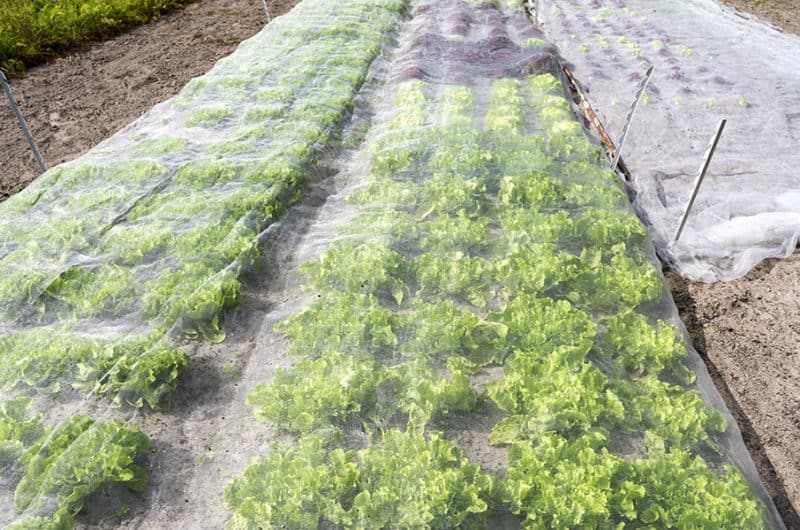
Install floating row covers to protect your vulnerable plants from a host of pests that attack during the growing season.
Trap Crops
Take advantage of interplanting techniques. Avoid a flea beetle infestation by planting trap crops between main crops and/or by planting certain herbs that the pests don’t like (e.g., basil).
Trap crops are plants that are planted only to act as a sacrifice for others in the garden. They are a decoy and meant to attract offending pests who leave your main crop alone.
Beneficial Nematodes
Add nematodes to your garden. Beneficial nematodes can help get rid of flea beetle larvae.
The Bottom Line
No one likes dealing with pests in the garden, but flea beetles don’t have to be a death sentence for your plants. With a few techniques and strategies, you can kill and prevent them from making a home in your garden.
